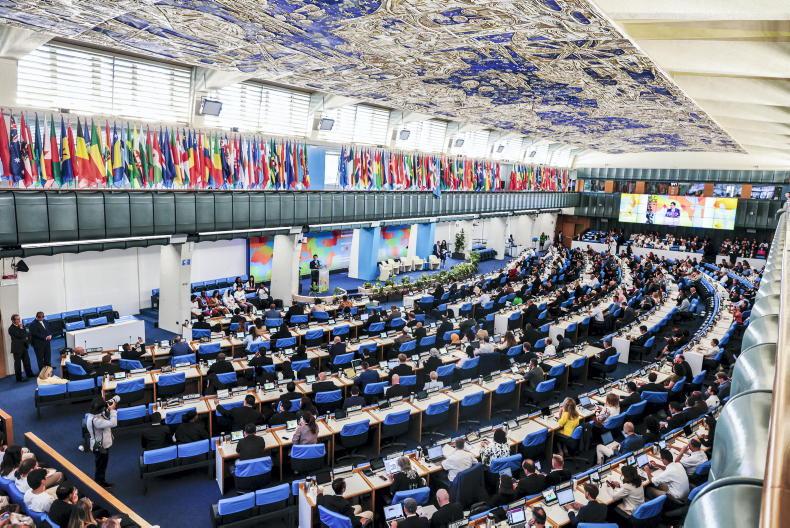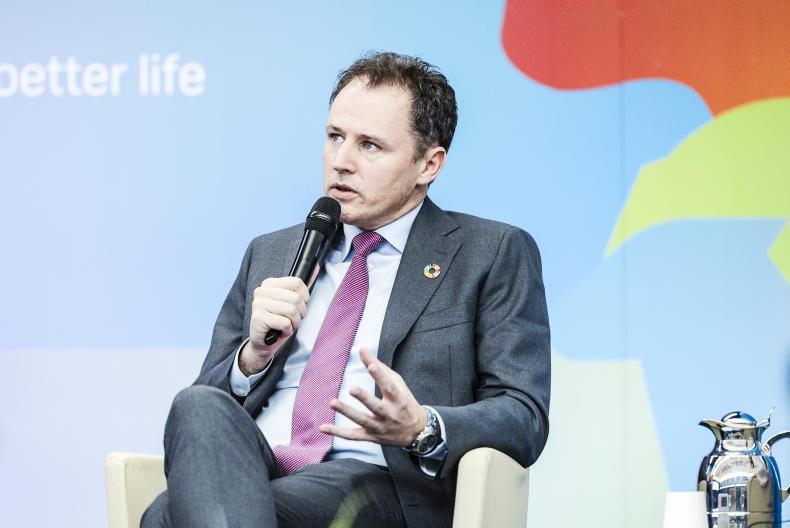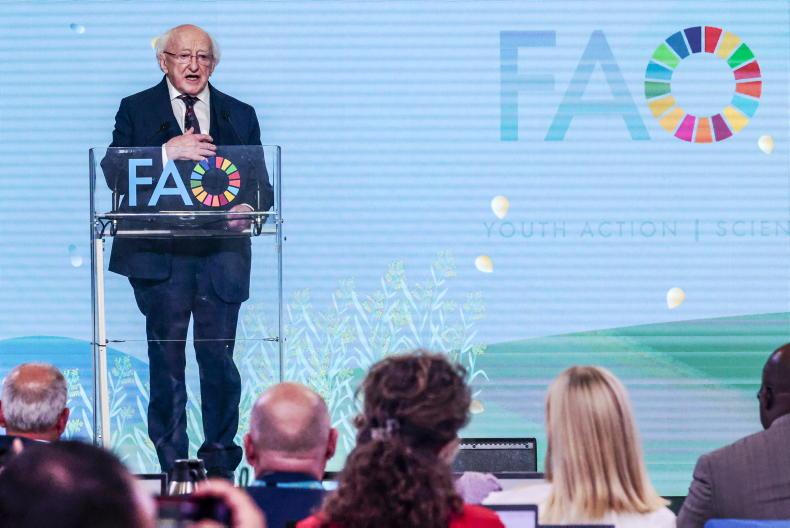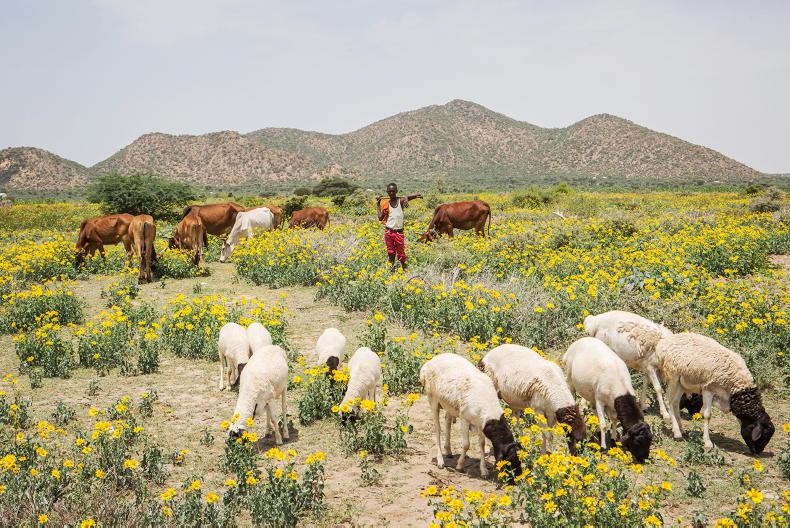The United Nations (UN), established in the aftermath of World War II, is an instantly recognisable global institution that is associated with conflict resolution and preservation of global peace.
As with all referees, it gets widely criticised and recent experience would suggest that it is struggling with its brief.
What is less well known to many people is that it has numerous departments dealing with other issues on a global basis.
One such institution is the Food and Agriculture Organisation (FAO), an agency of the UN that is headquartered in Rome.

Delegates at FAO Sustainable Livestock Transformation conference held in Rome 25 - 27 September 2023. \ FAO, Cristiano
Minichiello
Its brief is to “achieve food security for all and make sure that people have regular access to enough high-quality food to lead active, healthy lives”. It has 195 members, including the EU, and is active in over 130 countries.
This work is varied and depends on what the local need is. The FAO also produces multiple reports and hosts numerous events, usually with the dual objective of producing food to feed the poorest populations, while doing minimal environmental damage in the process.
One of the annual publications that has made increasingly grim reading in recent years is The State of Food Security and Nutrition in the World (SOFI), published this year in July.
It reported that between 691 and 783 million people faced hunger in 2022, an increase of 122 million compared with 2019.
Progress in Asia and Latin America has been offset by a worsening situation in Africa, where 20% of the population, double the global average, are exposed to hunger.
Climate change
It is widely recognised that the effects of climate change are often most acutely felt in many of the poorer parts of the world.
Images of crops failing in Africa because of drought are frequent, and small livestock farmers often roam miles to try and get forage and water. Many regions simply don’t have the temperate climate that Ireland has, which is so suitable for farming – livestock production, in particular.
An extreme view is frequently presented that ruminant livestock production should cease due to the emissions of greenhouse gases (GHG) that they create.
Whatever the theoretical validity of this point, in a world with an ever-increasing population, the potential to convert grass to a human food via beef and dairy production cannot be overlooked.
Indeed, much of the hands-on work of FAO are educating people on how to best to use meagre resources and achieve maximum output.
Sustainable Livestock
Transformation
In September this year, the FAO held its first ever Global Conference on Sustainable Livestock Transformation.
Professor Frank O’Mara, who, as well as being Teagasc’s director, is also president of the European Animal Taskforce, presented the Irish story on the drive for a 25% reduction in emissions by 2030 and the Teagasc MACC 2023.

Minister Charlie McConalogue at FAO Sustainable Livestock Transformation conference in September. \ FAO, Giuseppe Carotenuto
Minister of Agriculture Charlie McConalogue also participated, so the Irish story was well shared on this international livestock stage.
The reasons given by FAO for holding the conference were to:
Raise awareness of the contribution of sustainable livestock production to implementing the FAO Strategic Framework 2022-2031, and to achieve the Sustainable Development goals at global, national and regional levelsShare information and knowledge on the strategic direction and technical developments in sustainable livestock production worldwide.Establish priorities for the mobilization and pooling of scientific, technical and financial resources to achieve global, sustainable livestock transformation.In a world with an ever-increasing population, the potential to convert grass to a human food via beef and dairy production cannot be overlooked
The event itself concentrated on exploring four key themes as the key to delivering sustainable livestock transformation.
First among these was achieving better livestock production systems through “management and use of feed and animal genetic resources, animal health and welfare, digitalization and precision livestock farming”.
The second theme was the role of animal-source food for better nutrition, and the third was achieving livestock solutions for a better environment. The final theme was achieving a better life thorough supporting smallscale livestock producers to improve their livelihoods.
Lessons for all
It is striking to learn just how dependent so much of the developing world remains dependent on basic, indeed, subsistence agriculture to survive.
The key to progress for these people, many of whom are the poorest in the world, is to embrace technology to drive production and efficiency. This is a huge challenge when working with limited resources and information, and coping with the most difficult farming conditions on Earth.

President Michael D Higgins addressing the FAO Sustainable Livestock Transformation conference held in Rome 25 - 27 September 2023. \ FAO, Cristiano Minichiello
This type of farming is a different world from what is everyday practice in what is considered the developed world.
The US leads the way with embracing technology to drive production and productivity, some of which (eg, use of hormones) is rejected by the EU.
Despite that, yield from livestock, whether it is meat or dairy, is multiple times higher in Ireland than it is in the developing world where backyard-type herds are kept to produce primarily for domestic consumption, and anything leftover is sold or even bartered locally.
Modern intensive agriculture is often disparagingly referred to as “industrialised farming”. Yet, in the journey to reducing emissions per kilo of beef or litre of milk, this is the best direction of travel – because less livestock delivers more product.
It is a debate that society will continue to wrestle with, and the FAO of the UN is a forum where such a debate can take place.
The United Nations (UN), established in the aftermath of World War II, is an instantly recognisable global institution that is associated with conflict resolution and preservation of global peace.
As with all referees, it gets widely criticised and recent experience would suggest that it is struggling with its brief.
What is less well known to many people is that it has numerous departments dealing with other issues on a global basis.
One such institution is the Food and Agriculture Organisation (FAO), an agency of the UN that is headquartered in Rome.

Delegates at FAO Sustainable Livestock Transformation conference held in Rome 25 - 27 September 2023. \ FAO, Cristiano
Minichiello
Its brief is to “achieve food security for all and make sure that people have regular access to enough high-quality food to lead active, healthy lives”. It has 195 members, including the EU, and is active in over 130 countries.
This work is varied and depends on what the local need is. The FAO also produces multiple reports and hosts numerous events, usually with the dual objective of producing food to feed the poorest populations, while doing minimal environmental damage in the process.
One of the annual publications that has made increasingly grim reading in recent years is The State of Food Security and Nutrition in the World (SOFI), published this year in July.
It reported that between 691 and 783 million people faced hunger in 2022, an increase of 122 million compared with 2019.
Progress in Asia and Latin America has been offset by a worsening situation in Africa, where 20% of the population, double the global average, are exposed to hunger.
Climate change
It is widely recognised that the effects of climate change are often most acutely felt in many of the poorer parts of the world.
Images of crops failing in Africa because of drought are frequent, and small livestock farmers often roam miles to try and get forage and water. Many regions simply don’t have the temperate climate that Ireland has, which is so suitable for farming – livestock production, in particular.
An extreme view is frequently presented that ruminant livestock production should cease due to the emissions of greenhouse gases (GHG) that they create.
Whatever the theoretical validity of this point, in a world with an ever-increasing population, the potential to convert grass to a human food via beef and dairy production cannot be overlooked.
Indeed, much of the hands-on work of FAO are educating people on how to best to use meagre resources and achieve maximum output.
Sustainable Livestock
Transformation
In September this year, the FAO held its first ever Global Conference on Sustainable Livestock Transformation.
Professor Frank O’Mara, who, as well as being Teagasc’s director, is also president of the European Animal Taskforce, presented the Irish story on the drive for a 25% reduction in emissions by 2030 and the Teagasc MACC 2023.

Minister Charlie McConalogue at FAO Sustainable Livestock Transformation conference in September. \ FAO, Giuseppe Carotenuto
Minister of Agriculture Charlie McConalogue also participated, so the Irish story was well shared on this international livestock stage.
The reasons given by FAO for holding the conference were to:
Raise awareness of the contribution of sustainable livestock production to implementing the FAO Strategic Framework 2022-2031, and to achieve the Sustainable Development goals at global, national and regional levelsShare information and knowledge on the strategic direction and technical developments in sustainable livestock production worldwide.Establish priorities for the mobilization and pooling of scientific, technical and financial resources to achieve global, sustainable livestock transformation.In a world with an ever-increasing population, the potential to convert grass to a human food via beef and dairy production cannot be overlooked
The event itself concentrated on exploring four key themes as the key to delivering sustainable livestock transformation.
First among these was achieving better livestock production systems through “management and use of feed and animal genetic resources, animal health and welfare, digitalization and precision livestock farming”.
The second theme was the role of animal-source food for better nutrition, and the third was achieving livestock solutions for a better environment. The final theme was achieving a better life thorough supporting smallscale livestock producers to improve their livelihoods.
Lessons for all
It is striking to learn just how dependent so much of the developing world remains dependent on basic, indeed, subsistence agriculture to survive.
The key to progress for these people, many of whom are the poorest in the world, is to embrace technology to drive production and efficiency. This is a huge challenge when working with limited resources and information, and coping with the most difficult farming conditions on Earth.

President Michael D Higgins addressing the FAO Sustainable Livestock Transformation conference held in Rome 25 - 27 September 2023. \ FAO, Cristiano Minichiello
This type of farming is a different world from what is everyday practice in what is considered the developed world.
The US leads the way with embracing technology to drive production and productivity, some of which (eg, use of hormones) is rejected by the EU.
Despite that, yield from livestock, whether it is meat or dairy, is multiple times higher in Ireland than it is in the developing world where backyard-type herds are kept to produce primarily for domestic consumption, and anything leftover is sold or even bartered locally.
Modern intensive agriculture is often disparagingly referred to as “industrialised farming”. Yet, in the journey to reducing emissions per kilo of beef or litre of milk, this is the best direction of travel – because less livestock delivers more product.
It is a debate that society will continue to wrestle with, and the FAO of the UN is a forum where such a debate can take place.









 This is a subscriber-only article
This is a subscriber-only article










SHARING OPTIONS: